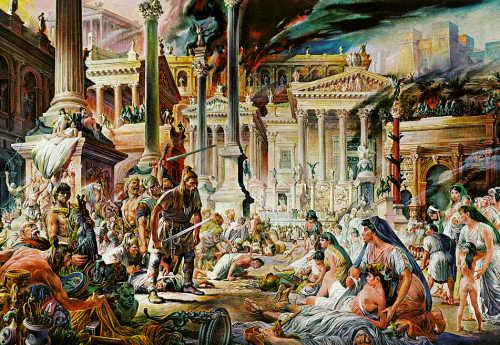4.9. 476 Decline of the Western Roman Empire
Categories: Years of war and revolution , Calendar

The Western Roman Empire ended in 476 when the last Roman emperor, Romulus Augustus, was crushed by the Visigothic invasion of Italy. It existed for 503 years and 6 months. Rome became a forgotten city in a forgotten land
When Emperor Theodosius I died in 395, the Roman Empire was divided by his sons and effectively split in two. The western part, with the capital Rome, was inherited by Honorius, who ruled between 395 and 423, and thus acquired territories including Italy, Africa, Spain, Illyria, Gaul and parts of Britain. The eastern part was acquired by Arcadius, who ruled between 395 and 408. He made Constantinople his capital, and to him fell the territory of Byzantium, comprising Macedonia, Dacia, Egypt, Orientis, Pontus, Thrace, and Asia.
Constantine failed then. "Christianity did not unify the empire, it merely gave it a semblance of uniformity for a moment. The Western Roman Empire ended in 476 when the last Roman emperor, Romulus Augustus, was crushed by the Visigothic invasion of Italy. It existed for 503 years and six months. Rome, once an imperial city where eagles flew as symbols of the ancient and glorious legions, became a forgottenm city in a forgotten land," write of Albany Prince Michael, Salhab Walid Amine in their book The Templars and the Secret Wisdom of Islam.
When Rome fell in 476, Constantinople took the reins and it was then that the true Byzantine Empire was born. Moreover, the Roman Church decided to take revenge on the Eastern Roman Empire. Out of the ashes of the Roman Empire rose "Pontifex Maximus". This was a title that Julius Caesar had usurped as Roman High Priest in 72 BC and retained until his death, and which had been usurped by his ancestors two hundred years before him. The Pope of Rome suddenly declared himself superior to all bishops of all branches of Christianity.
This claim was not new, but what was new was the theological vehemence on which it rested, and many in the West took it very seriously. Historically, this process culminated in what the Roman Catholic Church calls the "Donation of Constantine". The Eastern Church has always been suspicious of this matter, and it is now quite clear that it was nothing more than a forgery created by Rome to assert papal primacy over all Christendom, based on a document to be given by the Emperor Constantine the Great to the Bishop of Rome, Silvester I.
Constantine died in the Eastern Roman Empire, where he had previously settled in millennial Byzantium and made it the capital of what was later aptly called Constantinople, the present-day Istanbul. Riding on horseback and using the sword, Constantine altered the city's boundaries, enlarged it and surrounded it with a defensive wall.
Sources:
Albany Prince Michael and Salhab Walid Amine, The Templars and the Secret Wisdom of Islam
Michael Kerrigan, Rome
www.shorthistory.org
The article is included in categories: